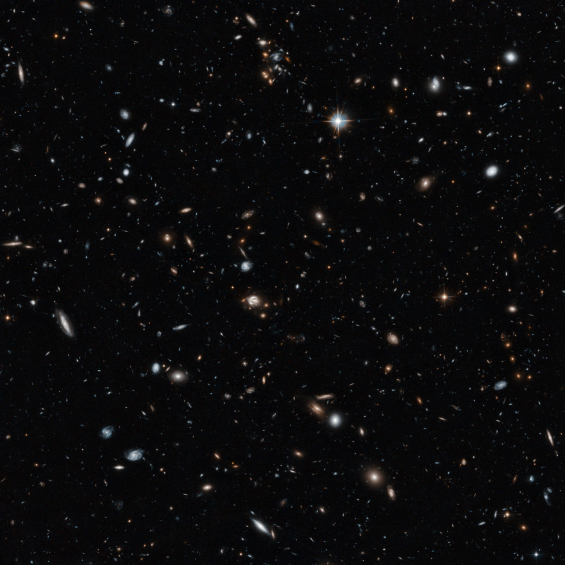A cross-section of the Universe [heic1408]
17 April 2014
An image of a galaxy cluster taken by the NASA/ESA Hubble Space Telescope gives a remarkable cross-section of the Universe, showing objects at different distances and stages in cosmic history. They range from cosmic near neighbours to objects seen in the early years of the Universe. The 14-hour exposure shows objects around a billion times fainter than can be seen with the naked eye.This new Hubble image showcases a remarkable variety of objects at different distances from us, extending back over halfway to the edge of the observable Universe. The galaxies in this image mostly lie about five billion light-years from Earth but the field also contains other objects, both significantly closer and far more distant.
Studies of this region of the sky have shown that many of the objects that appear to lie close together may actually be billions of light-years apart. This is because several groups of galaxies lie along our line of sight, creating something of an optical illusion. Hubble's cross-section of the Universe is completed by distorted images of galaxies in the very distant background.
These objects are sometimes distorted due to a process called gravitational lensing, an extremely valuable technique in astronomy for studying very distant objects [1]. This lensing is caused by the bending of the space-time continuum by massive galaxies lying close to our line of sight to distant objects.
One of the lens systems visible here is called CLASS B1608+656, which appears as a small loop in the centre of the image. It features two foreground galaxies distorting and amplifying the light of a distant quasar the known as QSO-160913+653228. The light from this bright disc of matter, which is currently falling into a black hole, has taken nine billion years to reach us – two thirds of the age of the Universe.
As well as CLASS B1608+656, astronomers have identified two other gravitational lenses within this image. Two galaxies, dubbed Fred and Ginger by the researchers who studied them, contain enough mass to visibly distort the light from objects behind them. Fred, also known more prosaically as [FMK2006] ACS J160919+6532, lies near the lens galaxies in CLASS B1608+656, while Ginger ([FMK2006] ACS J160910+6532) is markedly closer to us. Despite their different distances from us, both can be seen near to CLASS B1608+656 in the central region of this Hubble image.
To capture distant and dim objects like these, Hubble required a long exposure. The image is made up of visible and infrared observations with a total exposure time of 14 hours.
Notes
[1] Gravitational lensing can amplify the light coming from distant objects, enabling telescopes like Hubble to see objects that would otherwise be too faint and far away. This effect will be exploited during the Frontier Fields observing campaign in the near future, which aims to combine the power of Hubble with the natural amplification caused by strong gravitational lensing of distant galaxy clusters, to study the past Universe.
More information
The Hubble Space Telescope is a project of international cooperation between ESA and NASA.
The image was spotted by contestant Adam Kill in the 2012 Hubble's Hidden Treasures competition. Hidden Treasures invited members of the public to search Hubble's science for the best overlooked images that have never been seen by a general audience. This image of CLASS B1608+656 has been well-studied by scientists over the years, but this is the first time it has been published in full online.
Contacts
Georgia Bladon
Hubble/ESA
Garching, Germany
Tel: +49-89-3200-6855
Email: gbladon![]() partner.eso.org
partner.eso.org




